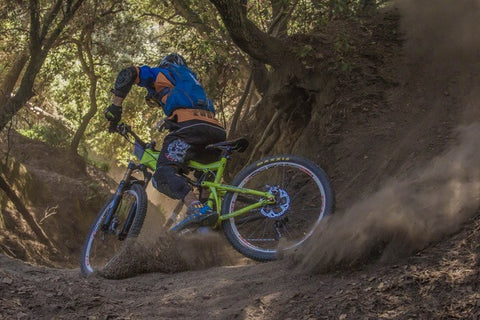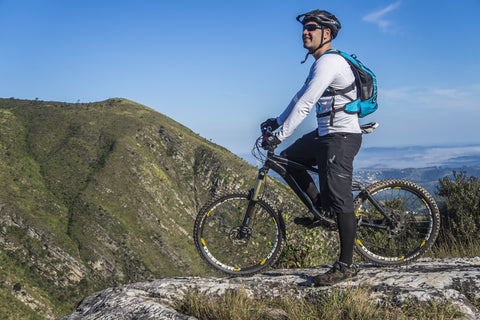Enduro mountain biking is a multifaceted and dynamic cycling discipline!
It combines the physical endurance of cross-country mountain bike riding with the excitement and technical difficulty of downhill mountain bike racing.
Enduro mountain bike racing began in Europe with the influence from motorbike, enduro racing and car rally racing. The concept was simple: to get to the top of a mountain and race to the bottom time trial style.
Today, enduro races have three to six timed stages. In most cases, these timed stages are usually downhill but can vary in length, steepness, and difficulty depending on location. There are untimed “transfer stages” between each stage that are mostly uphill. Transfer stages can involve sections of good old-fashioned pedaling, a chair lift and hike-a-bike, depending on the race.
Each enduro race has a different skill, style, and fitness requirement as well as a set of rules unique to each event. But for the most part, enduro is meant to be a convenient, fun and exciting form of mountain biking. It is an awesome form of mountain biking meant for all levels of riders.
Are you new to enduro mountain biking and want to know how to get started? This article will provide all the essential details you need to get involved. 
Why Enduro Mountain Biking is Ideal for Newbies
Even though it does require some skill and physical fitness to complete the course, Enduro Mountain Biking is an approachable cycling discipline for starters. Here are a few reasons to prove it.
• The People are Amazing
Unlike other forms of mountain bike racing, enduro is known to have a friendly atmosphere. Wait for your friends to finish the time stage runs and then ride to the top together. And of course, celebrate with the new and old friends at the finish line with race take, tasty beverages, and delicious food.
• Everyone Rides the Same Course
With enduro racing, everyone rides the same course regardless of the skill level or gender. Thus, you can compare your times to everyone else’s regardless of your classification.
• It is Easy to Handle
During Enduro races, it is just you, your bike and the clock. There are no worries when it comes to passing or getting passed since you are sent off down the trail at 30 seconds to 1-minute intervals. If you get passed or need to pass someone, it is usually just one person at a time. This makes it much easier to handle than a whole group in an XC race.
• It is a Motivated Trail Ride
Enduro is a form mountain bike riding that you can do with a bunch of new and old friends. It continually motivates you to push your limits on the descents.
• You Can Carry Your Pack Around
In other forms of racing, you will be scoffed at for carrying a bag. However, in enduro, it is quite important you have a bag. If you get flat or other mechanical, you are responsible. You will certainly love the opportunity for snacking!
How to Choose the Right Enduro Mountain Bike Newbies
It is absolutely essential that you choose the right enduro mountain bike. If not, your confidence, happiness, and handling skills will suffer. You will want a bike you can ride up and down hills all day. Here are valuable tips on how to choose the right enduro mountain bike for your ride.
Tip 1: Find the Right Fit
Bikes are manufactured in a large variety of sizes ranging from xx-small, extra small, small, medium, large and extra large. Sizing is not consistent across manufacturers. Thus, it is essential to check the actual measurement and the manufacturer’s guideline for fit and sizing. Some of the key aspects to consider are:
• Reach: This is the distance from the center of the head-tube, horizontally out to the point above the center of the bottom rack. It is important to ensure your bike has the right reach to prevent your knees knocking the handlebars when climbing.
• Stand-over Height: The stand-over height is how tall your bike is at the point you stand over it. You should have a minimum of 2 inches between the top tube and yourself. A maximum of 5 inches is also fine for aggressive rides. An ideal stand-over height helps you figure out how likely you are to take a very unpleasant shot on a quick/surprise dismount.
• Effective Top tube Length: This is the horizontal distance from the center of the seat tube to the center of the head tube. This measurement affects your biking comfort, controlling how stretched out you are hen riding.
Tip 2: Choose the Right Suspension
The type of suspension your enduro mountain bike should have depends on the terrain you will be riding on. If the trails are steep and technical, you will want a bike with a higher squash (140 -160mm of travel). If you are planning to participate in a local enduro that does not involve lots elevation changes, you can choose a bike with less travel (100 to140mm of front and rear suspensions.)
Tip 3: Go for the Best Groupset
A groupset consists of brakes and the bike’s drivetrain. The drivetrain is made up of a crankset with chain-rings, a cassette of gears on the rear wheel, a chain, a rear derailleur and a shift to operate it all. For the groupset components, more expensive means lighter and better construction. This can translate to a smooth operation and enhanced durability.
Modern mountain bikes are fitted with disk brakes. These brakes are made up of a wheel-mounted metal plate gripped by hydraulically operated calipers. When choosing disk brakes, consider the size of the metal plate, called a rotor, a bigger one will give you more braking power.
Tip 4: Choose the Right Tires and Gearing
Researching your trail conditions will help determine what tires are ideal for you. Some of the key factors to consider when choosing tires include weight, traction, and size. Heavier tires are slower to spin, but are quite durable. Less traction equals more speed. More traction equals more control and likely a little more weight. Most mountain bike tires are 2.3’’ across. However, there are now plus-sized tires that range from 2.5” to 2.8”. These provide a bit of extra suspension and more traction. Wheels also affect the size of the tires; wide rims allow the tire to square off and spread, offering better traction.
When it comes to choosing the gearing, go for a wide selection. This is because enduro mostly covers the spectrum from steep and fast descents to long and technical uphills. On top of this, chain guides are also a good idea for those rough downhills.
Tip 5: Choose the Large Wheel Size
The wheel sizes of most mountain bikes today are 27.5 inches to 29 inches. Large wheel sizes impact roots or rocks at shallower angles, allowing the wheel to roll over obstacles easily. Thus, most lines are easier to clean on bigger wheels. The 27.5-inch wheel size is more stable and maneuverable than 29 inches ones. The 29-inch wheel, on the other hand, has a larger contact patch connecting with the ground. This gives you more grip when hammering on the pedals.

Enduro Race Essentials: The Checklist for the Beginner Competitor
Carrying he right equipment in enduro racing, will help to keep you safe and allow you to concentrate and most importantly enjoy the task at hand. Here are the essentials for an enduro race:
• A Full Face Helmet
Full face helmets are increasingly becoming a mandatory kit for the timed sessions of many enduro races. For that reason, it is possible you will need one for your race. However, each event is different and it important you take a good look at the regulations of the event in question. But one thing for sure, you will be required to wear some type of helmet at all times. Thus, consider the weather, steepness, terrain when choosing a helmet for your event. Many riders carry a pack that allows them to strap an extra helmet to swap into for the transfer section between stages.
• Knee Pads
As a rider, it is quite important to look after your knees. There are many types of knees pads available in the market today, and it is vital you choose pads that will keep your elbows, shins and knees well protected.
• Gloves
Riding gloves help to protect from painful injuries. When paired with the right set of grips, gloves help to prevent your hands from getting sweaty or torn up.
• Back/ Hydration Pack
It is important that you keep yourself hydrated during the race. A well-sorted hydration pack means that you will have all the items you need to make your race enjoyable. You can bring items such as basic fix-a-flat tools, your phone, food, and enough water to last you the day. Hydration packs include a spine protector, which adds useful protection without affecting the comfort of the rider. Moreover, it is important to pack the right contents in your bag. Avoid putting heavy and solid objects that could pose a risk to your body in a crash scenario.
• Eyewear
Riding in your first enduro might be an emotional experience, but you do not want to end your day with bleary red eyes. Thus, goggles or cycling glasses are essential part of your enduro kit. Eyewear not only protects you from flying mud and debris but also ensures that you can see as you fly down the trail.
• Waterproof Jacket
You certainly do not know how weather will be like the entire day. That is why it is important to keep a decent packable waterproof jacket in your bag at all times.
• Shoes
The right footwear is quite essential. Clipless shoes will give you a power advantage. However, riders who love the freedom of flats are now split for choice by a selection of stiff soled shoes.
• Long Sleeves and Baggy Shorts
You can race an enduro in your skin suit. However, the more clothing you have on, the more protected you are going to be should you have a fall.
• Tooling
Some tools you carry with you include, at least one inner tube, trusty tire levers, CO2 inflator and a few cartridges. These tools will help you back on the trail as quickly as possible, if you find yourself deflated. Consider adding a regular multi-tool as it provides you with everything you need to fix most mechanical mishaps.
Top Reasons Why Enduro Mountain Biking is Awesome
Enduro mountain biking is not just a sport. It is a way of life. Here are top reasons why enduro mountain bike newbies is awesome.
Biking gives you a Better Workout
Enduro mountain biking improves your cardiovascular fitness for spinning at high cadence for a long time. Mountain biking requires much more dynamic fitness from quick bursts to sustained cardio outputs, and incorporates many muscle groups.
Quite and Solitude
Enduro mountain bike trails usually take you to remote, peaceful places, where you can enjoy the great outdoors, mediate and commune with nature. It is rare to get such opportunities on a road bike, unless you live in an area with rarely-used paved roads.
Bring Adventure into Your Life
Enduro mountain biking is by nature a pretty adventurous sport, which evokes a certain spirit of risk-taking and exploration. Since it is adventurous, it certainly makes you a much more interesting person.
Better Networking
Whether you are struggling through strains of physical exertion or assisting a fellow rider fix a flat tire, enduro mountain biking offers insights into your friends and partners that other races cannot offer. Their strength, determination, and attitude of their resolve will all come to light. This sport allows you to actively network more actively with other riders.
Get Close to Nature
Research shows that those who are able to distance themselves from everyday havoc and noise find reprieve in the tranquility of nature are more energetic, less stressed and happier. Enduro mountain biking allows you to get back into nature, real nature.
Enduro mountain biking is an awesome cycling discipline for both newbies and pros. As mentioned earlier, enduro races vary widely. Some races cover up to 40 miles, climb 8,000 feet, and an hour of time sections, over rough terrain. Others cover 15miles, very little elevation and have a total of about 20 minutes times descents. Pick your race based on your strength. If you are unsure of your ability on more technical trails, go for a race in a flatter region. If you like riding downhill, pick a race at a ski mountain where you can rally technical descents, and may be lucky to catch the chairlift back to the top.
(Picture credit: Bike List)
